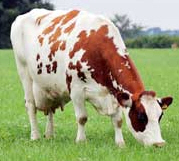



Estonian Red
History
Estonian Red cattle have evolved from continuous crossbreeding of the the native Estonian cattle with the Angler and Danish Red cattle. This crossbreeding started in the middle 1800's with the aim to create a breed which produced milk with a high fat content and an increased yield. Later on more attention was focused on weight and body size. The first Estonian Red animals were entered in the herdbook in 1885.The Estonian Red started to spread throughout Estonia towards the end of the 19th Century although a great number of herds perished during World War 1 and 2. In 1916 there were 269,000 cows which was reduced to 225,000 by 1920. A strong advocate of the breed Jaan Mägi set up the Estonian Angler Breeders' Society in 1919 to help the breed, and in 1928 he renamed the breed to what it is known today, the Estonian Red, it has been gaining popularity ever since.
In 1993 the European Red Dairy Breed Association was set up in Denmark which aims to improve Red breeds to make them more economical, provide opportunities for breeders and increase communication between European Red cattle breeders with the Estonian Red being one of the five breeds. This breed is also part of the International Red Cow Club.
In the last 10 years seven different breeds have been used to inprove this breed, these are, Angler, Danish Red, Swiss, Red Holstein, Norwegian Red, Ayshire and Swedish Red and White. The Estonian Red is now fully restored to its popular position and is fully competitive with the Estonian Holstein, as now it accounts for 63.3% of all cattle in Estonia.
Characteristics
The Estonian Red is medium in size with a strong frame. The coat colour is red and can range from light to dark, the bulls tend to be dark.Some body measurements are as follows; withers height 127.5cm, chest depth 70cm, chest width 45.5cm, oblique body length 157.9cm, heart girth 195.6cm, cannon bone girth 18.3cm.
The mature cows weigh 450 to 550 kg with a maximum of 780 kg and mature bulls weigh 800 to 900 kg again an approximate maximum of 1000 kg. Calves at birth weigh 31 to 33 kg.
The milk yield of 164,900 evaluated cows was 3456 kg with 3.92% fat. The production of Estonian Red cattle at 77 breeding farms is as follows; average milk yield per cow 3784 kg, fat content 3.98%, protein content 3.30%. In 12 high producing herds the average milk yield per cow during a 305 day lactation amounts to 4127-5029 kg, and fat content is 3.90-4.18%. There are 25 record holders in these herds: including cow 5338 - 5th lactation, 9610 kg milk, 4.14% fat; cow 4519 - 7th lactation, 8554 kg of milk, 4.47% fat; cow 2431 - 2nd lactation, 7806 kg milk, 4.65% fat.
Improvement of the Estonian Red is being carried out by pure breeding and by crossbreeding with the Danish Red and the Angler. The new type with Angler blood should have the following performance; milk yield not less than 7000 kg with 4.0% fat, milking rate 1.9 kg per minute, live weight of cows over 600 kg and wither height of at least 140cm.
Statistics
Comparative
Distribution
This breed is produced in Estonia.References (the above information was cited from the following sites)
www.ansi.okstate.edu
www.eau.ee


